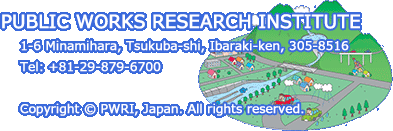Home > PWRI Outline > Message from the Chief Executive
PWRI Outline
Message from the Chief Executive

Taketo UOMOTO
Chief Executive
Incorporated Administrative Agency Public Works Research Institute (PWRI)
Chief Executive
Incorporated Administrative Agency Public Works Research Institute (PWRI)
I am Taketo Uomoto. On August 10, I was honored to be appointed as the Chief Executive of PWRI. I look forward to working with you all during my tenure in this important post.
The goals of PWRI are to improve civil engineering technologies, to contribute efficient development of high quality social infrastructure, and to promote to the further development of Hokkaido by performing R&D, technical guidance regarding civil engineering technologies and dissemination of the research achievements. The parent organizations of PWRI are the Road Materials Testing Department in the Public Works Bureau, Ministry of Internal Affairs established in 1921 and the Testing Laboratory of the Civil Engineering Department, Hokkaido Prefectural Government of the Ministry of Internal Affairs established in 1937. Since its founding, through the efforts of its former personnel, PWRI has worked hard to develop numerous new technologies and spread the use of these technologies. In addition we have fulfilled its technological mission of designing, constructing, and maintaining numerous public works structures which not only preserve the safety of Japan, a nation vulnerable to typhoons, earthquakes, and disasters of many other kinds, but also play a vital role in supporting the economic growth of our nation.
In 2001, as part of administrative reforms, PWRI and the Civil Engineering Research Institute of Hokkaido were established as Incorporated Administrative Agency, and then in 2006, the two organizations were merged and begun anew.
As we enter the 21st century, we are aware of the importance of not only constructing new structures, but of building national land and society where people can live lives free from fear, and we must provide social infrastructure which fully considers not only safety, but the needs of the environment. Naturally, as all of you know, holding down costs is also vital, and since the Lehman Shock in particular, Japan has entered a period of sweeping change, when we must limit new construction in response to a major change in the allotment of budgets and to government policies.
In response, PWRI has, considering recent social conditions, established four characteristic research centers: the Tsukuba Central Research Institute, Civil Engineering Research Institute for Cold Region (CERI), International Centre for Water Hazard and Risk Management (ICHARM), and the Center for Advanced Engineering Structural Assessment and Research (CAESAR). Each is now working to contribute to society through research activities reflecting their respective objectives. And as the share of budgets allotted to new construction in Japan continues to fall in the future, we must take action to deal with construction problems occurring outside of Japan. I wish to do all that I possibly can so that the PWRI can become a research institute renowned not only in Japan, but throughout the world.
Having received this appointment to the important post of Chief Executive of the PWRI in this period of sweeping change, I intend to devote all of my energy, as limited as it is, to fulfilling my role. I beg you for your corporation in this task.
| June | 1971: | Graduated from the Department of Civil Engineering, the University of Tokyo |
| July | 1971: | Joined Taisei Corporation |
| Jan. | 1978: | Resigned from Taisei Corporation |
| Feb. | 1978: | Research Associate at the Institute of Industrial Science (IIS), University of Tokyo |
| Sept. | 1981: | Associate Professor at the IIS, University of Tokyo |
| Feb. | 1992: | Professor at the IIS, University of Tokyo |
| April | 1996: | Director of the Central Workshop of the IIS, University of Tokyo (joint appointment until March 2000) |
| July | 1998: | Professor, International Center for Collaborative Research, University of Tokyo |
| April | 2000: | Deputy Director of the IIS, University of Tokyo (joint appointment until March 2002) |
| April | 2001: | Director and Professor at the International Center for Urban Safety Engineering of the IIS, University of Tokyo |
| April | 2003: | Director of the Chiba Experiment Station of the IIS, University of Tokyo (joint appointment until March 2007) |
| March | 2007: | Resigned from the IIS, University of Tokyo |
| April | 2007: | Professor at College of Engineering, Shibaura Institute of Technology |
| June | 2007: | Professor Emeritus at University of Tokyo |
| Aug. | 2010: | Resigned from Shibaura Institute of Technology |
| Aug. | 2010: | Appointed as the Chief Executive of Public Works Research Institute |













